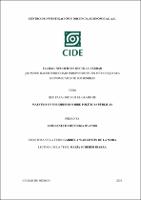| dc.contributor.advisor | Gabriela Warkentin de la Mora |
| dc.creator | Mendoza Ovando, Luis Ernesto |
| dc.date.issued | 2021 |
| dc.identifier | 173811.pdf |
| dc.identifier.uri | http://hdl.handle.net/11651/4449 |
| dc.description.abstract | La pandemia ha mostrado a la industria periodística como una cadena de eslabones débiles: la calidad de los reportajes es frágil porque el oficio se encuentra bajo constante amenaza; las cadenas de distribución son endebles porque los medios compiten bajo las reglas opacas que los algoritmos dictan; los medios de comunicación están apenas en pie porque la mayor parte de los modelos de negocios de las empresas periodísticas tradicionales son altamente dependientes de la publicidad oficial. Pese a estas condiciones, existen ejemplos de nuevos medios de comunicación que comienzan, desde una escala más pequeña, a reforzar los eslabones de su oficio y plantear desde la práctica un periodismo que no solo sobreviva, sino que sea capaz de crecer y florecer en la nueva normalidad. Sin embargo, para entender los nuevos rumbos del oficio, es preciso adentrarse primero en el periodismo que está en crisis: el tradicional, el que ya estaba vivo cuando llegó Internet, el que es generalista y tiene corresponsales en todo el país, el de las grandes oficinas y redacciones. Entender cómo ha variado su dependencia de la publicidad oficial en los últimos 20 años, la época posterior a la alternancia democrática del 2000, y cómo ha cambiado la relación entre prensa y gobierno en medio de una pandemia que trajo consigo una crisis económica sin precedentes permitirá encontrar las claves que han permitido a un puñado de medios independientes y nativos encontrar en la crisis una oportunidad. |
| dc.description.abstract | The COVID-19 pandemic has shown the newspaper industry as a chain of weak links. The quality of the journalistic works is fragile because the profession is under constant threat. The distribution of information is sloppy and inadequate because the media compete under the opaque that the algorithms dictate. The media is barely standing because most of the business models of traditional newspaper companies are highly dependent on official advertising. Despite these conditions, there are examples of new media that begin (from a smaller scale) to reinforce the news media ecosystem and to promote a journalism that seems capable of growing and flourishing in the future. However, in order to understand the successful examples is necessary to take a look on the journalism in crisis: the traditional one, the one that was already alive when the Internet arrived, the one that is generalist and has correspondents throughout the country, that of the large offices and newsrooms. Understand how their dependence on official advertising has changed in the last 20 years, after the democratic alternation of 2000, and how the relationship between the press and the government has changed in the midst of a pandemic that brought with it an unprecedented economic crisis. By understanding this terrain that is currently uphill, it is possible to find the keys that have allowed to some independent and native media projects to transform the crisis to opportunities. |
| dc.format | application/PDF |
| dc.language.iso | spa |
| dc.publisher | El Autor |
| dc.rights | Con fundamento en los artículos 21 y 27 de la Ley Federal del Derecho de Autor y como titular de los derechos moral y patrimonial, otorgo de manera gratuita y permanente al Centro de Investigación y Docencia Económicas, A.C. y a su Biblioteca autorización para que fije la obra en cualquier medio, incluido el electrónico, y la divulguen entre sus usuarios, profesores, estudiantes o terceras personas, sin que pueda percibir por tal divulgación una contraprestación. |
| dc.subject.lcsh | Online journalism -- Mexico. |
| dc.subject.lcsh | Newspaper publishing -- Technological innovations -- Economic aspects -- Mexico. |
| dc.title | El (mal) negocio de decir la verdad: ¿se puede hacer periodismo independiente en México que sea económicamente sostenible? |
| dc.title.alternative | The costly business of telling the truth: an analysis of the independent journalism business model in Mexico |
| dc.type | Tesis de maestría |
| dc.accessrights | Acceso abierto |
| dc.recordIdentifier | 000173811 |
| dc.rights.license | Creative Commons Reconocimiento-NoComercial-SinObraDerivada 4.0 Internacional CC BY-NC-ND |
| thesis.degree.grantor | Centro de Investigación y Docencia Económicas |
| thesis.degree.name | Maestría en Periodismo sobre Políticas Púbicas |
| dc.proquest.rights | Yes |


